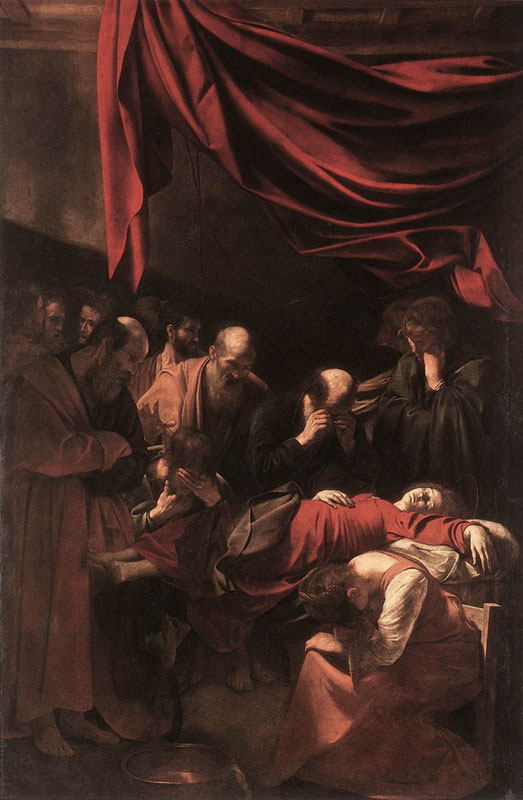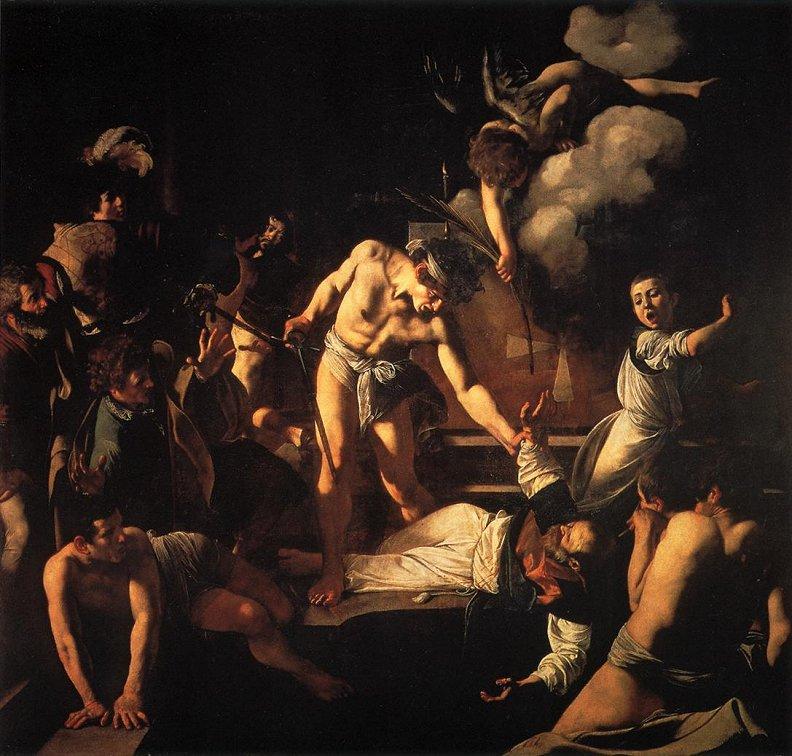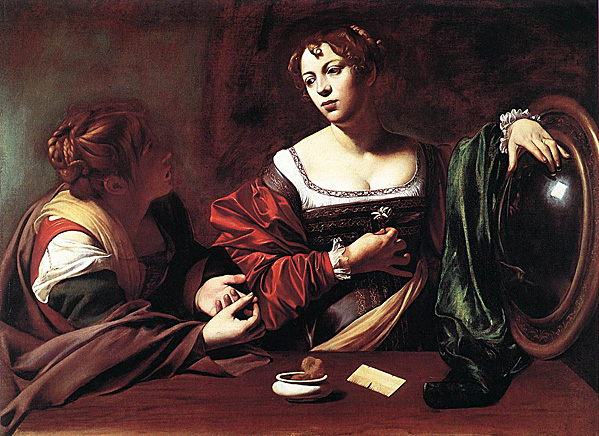Caravaggio’s novelty was a radical naturalism which combined close physical observation with a dramatic, even theatrical, use of Tenebrism, the shift from light to dark with little intermediate value. He burst upon the Rome art scene in 1600 with the success of his first public commissions, the Martyrdom of Saint Matthew and Calling of Saint Matthew. Thereafter he never lacked for commissions or patrons, yet he handled his success atrociously.

The Death of the Virgin. 1606. "The depiction of the Death of the Virgin caused a contemporary stir, and was rejected as unfit by the parish. Subsequently, upon the recommendation by Peter Paul Rubens, who praised it as one of Caravaggio's best, the painting was bought by Charles I, Duke of Mantua. It then travelled to the Court of Charles I of England, and finally to France. Today it hangs in the Louvre. Prior to leaving Rome, it was exposed at the Academy of Painters for under two weeks, however, by then, Caravaggio had fled Rome, never to publicly return. During one of his frequent brawls in Rome, the mercurial and impulsive Caravaggio killed a man, Ranuccio Tomassoni, during a sword fight after a tennis game."
Famous, and notorious, while he lived, Caravaggio ( 1570-1609 ) was forgotten almost immediately after his death, and it was only in the 20th century that his importance to the development of Western art was rediscovered. Despite this, his influence on the new Baroque style that eventually emerged from the ruins of Mannerism, was profound. It can be seen directly or indirectly in the work of Rubens, Jusepe de Ribera, Bernini, and Rembrandt, and artists in the following generation heavily under his influence were called the “Caravaggisti” or “Caravagesques”, as well as Tenebrists or “Tenebrosi” (“shadowists”). Andre Berne-Joffroy, Paul Valéry’s secretary, said of him: “What begins in the work of Caravaggio is, quite simply, modern painting.”
Biography
When Caravaggio obtained, through the influence of Cardinal Del Monte, his first big religious commission: “The Vocation of Saint matthew” and ” The Martydom of Saint Matthew”, two paintings for the Contarelli Chapel of San Luigi dei Francesi, he was not quite thirty. He wanted to rivet the attention of Rome with one commanding gesture, and he very nearly succeeded. “The martyrdom of Saint Matthew” is a titanic hodgepodge , confused, uneven , with a difficult to read narrative, but manifestly beyond the ambitions, let alone the capacity, of most of Caravaggio’s Roman contemporaries. Matthew lies prostrate on a step, an unconvincing angel writhing down on a cloud to hold his palm while an almost naked executioner prepares to skewer him.

The Martyrdom of Saint Matthew. "...caused Caravaggio considerable difficulty, as he had never painted so large a canvas, nor one with so many figures. X-rays reveal two separate attempts at the composition before the one we see today, with a general movement towards simplification through reduction in the number of figures, and reduction - ultimately elimination - of the architectural element. The first version revealed by the x-rays is in the Mannerist style of the most admired artist in Rome at the time, Giuseppe Cesari, with a crowd of small figures amidst massive architecture. It must have seemed static and distanced. The second version turned to Raphael for a model, adding a crowd of onlookers displying fear and pity, including a woman who presumably represented the nun. This was in line with the crowded scene requested by Cardinal Contarelli and with the tenets of Mannerism, which demanded bodies and buildings defined by perspective and drawing, but Caravaggio had already developed a personal style in which bodies were defined by light and darkness and in which backgrounds were eliminated. At this point Caravaggio left off the "Martydom" and turned his attention to the companion piece, the "Calling". This drew on his own earlier genre-pieces, "Cardsharps" and "The Fortune Teller", but writ large. Apparently re-inspired, or perhaps with renewed self-confidence, Caravaggio turned back to the "Martydom", but this time working in his own idiom. The third version dropped the architecture, reduced the number of actors, and moved the action closer to the viewer; more than this, it introduced the dramatic chiaroscuro which picks out the most important elements of the subject, in much the same way a spotlight picks out the action on a stage, but centuries before spotlights were imagined, and chose to represent the moment of greatest drama, as the murderer is about to plunge his sword into the fallen saint. This is the version we see today, the action caught at the moment of highest drama, the bystanders reduced to supporting roles by the sharply selective light, the whole giving the impression of a moment seen as if in a lightning flash."
This splendid figure of the martyr is the hub of the picture, and around him, limbs and bodies churn through the void like the spokes of a wheel. The four witnesses in their “modern” dress, the incomprehensible trio of giants looming from the bottom of the composition, the panicking boy and, in the background, a frowning self-portrait of Caravaggio himself. The last is one of a number of “unobserved watchers” who recur in Caravaggio’s mature paintings, suggesting that he had some acquaintance , however indirect, with Leonardo da Vinci’s work. Another suggestion of apparent contact is an image Caravaggio developed almost to obsession in contrating vitality and death. These are the paired heads of an old woman and a young woman, which sometimes appear, as in many of Leonardo’s images of the Virgin and Saint Anne, to be growing out of one common trunk.

The Conversion of Saint Paul. "The painting depicts the moment recounted in Chapter 9 of Acts of the Apostles when Saul, soon to be the apostle Paul, fell on the road to Damascus. He heard the Lord say "I am Jesus, whom you persecute, arise and go into the city." The Golden Legend, a compilation of medieval interpretations of biblical events may have framed the event for Caravaggio. On this canvas, Saul is an epileptic and fractured figure, flattened by the divine flash, flinging his arms upward in a funnel. There are three figures in the painting. The commanding muscular horse dominates the canvas, yet it is oblivious to the divine light that defeated his rider's gravity. The aged groom is human, but gazes earthward, also ignorant of the moment of where God intervenes in human traffic. Only Saul, whose gravity and world has been overturned lies supine on the ground, but facing heaven, arms supplicating rescue. The groom can see his shuffling feet, and the horse can plod its hooves, measuring its steps; but both are blind to the miracle and way. They inhabit the unilluminated gloom of the upper canvas. Saul, physically blinded by the event for three days, suddenly sees the Christian message. For once, his soul can hear the voice of Jesus, asking, "Saul, Saul, why do you persecute me?" His sword and his youthful sinews are powerless against this illuminating bolt of faith."
And the commissions kept on coming: “The Conversion of Saint-Paul” and the “Crucifixion of Saint Peter” for the Cerasi Chapel in Santa maria del Popolo in 1600; ‘The Death of the Virgin” in 1605; a dozen more between them. “The Conversion of Saint Paul, one of Caravaggio’s most and perhaps most justly celebrated works, disciplines the flailing drama of “The Martyrdom of Saint Matthew” . Paul, stricken from his horse on the way to Damascus, lies on his back, arms outflung, pinned like a bug on a shaft of revelation whose physical form is a blast of light from the sky. Yet the event is relentlessly matter-of-fact, the light that changes Paul’s life also illuminating, in an ordinary, direct way, the barrel and fetlocks of his skewbald horse, while his companion, bending over the bridle, is quite indifferent to it. The furrowed skin and casually lifted hoof are uncompromisingly naturalistic, like the executioner’s horny soles in the “Crucifixion of Saint Peter”. Yet the painting is a piercing metaphor of the singularity, if not quite the subjectivity, of religious experience. It is a violent thing.

The Crucifixion of Saint Peter. "The Crocifissione di san Pietro by Michelangelo Merisi da Caravaggio, more often known as Caravaggio, was painted for the Cerasi Chapel of Santa Maria del Popolo in Rome. The painting depicts the martyrdom of St. Peter by inverted crucifixion, as Peter asked that his death should not mirror Christ's. The large canvas shows Roman soldiers, their faces shielded, struggling to erect the cross of the elderly but muscular St. Peter. Peter is heavier than his aged body would suggest, and his lifting requires the efforts of three men, as if the crime they perpetrate already weighs on them. The work was comissioned along with a second Caravaggio (The Conversion of Saint Paul on the Road to Damascus, 1601), as well as an altarpiece by Carracci, by Monsignor Tiberio Cerasi in 1600. Caravaggio's original versions of both paintings were rejected by Cerasi but when he died shortly thereafter, replacement versions, which were more unconventional than the first, were accepted without comment by the executors of his estate in 1601."
Which is only to be expected. Caravaggio was a connossieur of violence. Throughout his Roman prosperity he never extracted himself from trouble with the authorities. His landlady sued him for rent, and baglione sued him for libel; losing that case, he was calpped under house arrest for a time. He fought duels over women, for Caravaggio seems clearly bisexual, wounded a guard at Castel Sant’ Angelo, was arrested for possessing an unlicensed sword, and nearly killed a waiter at the Osteria del Moro one night in 1604. The minion brought Caravaggio a dozen artichokes, six cooled in oil, six in butter. Which, the painter demanded, were which? “Yaste them and you will see,” said the surly waiter; whereupon Caravaggio flung the metal dish at the man’s head, leapt up, and was about to skewer him with his rapier. One can respond to this incident with a bit of sympathy, but, whether the incidents themselves were comic or dangerous, he was clearly embarked on a switchback of violence.
“Caravaggio was the Jim Morrison of his time — Rimbaud with a paintbrush. There was little that was pious or holy about the man with a gift for holy and sacred art. Caravaggio’s world was the world of drunken singing, back-alley brawls,
titutes, thieves and ne’er-do-wells. Not for him the abstinence of the monk. Caravaggio desired the physical, the earthly. But perhaps if he hadn’t been such a drunken, violent, criminal, he may never have been human enough, disturbed enough or repentant of enough sin to produce the terrible realism for which he is justly famous.”

The Conversion of the Magdalene. 1598-99. "Martha and Mary was painted while Caravaggio was living in the palazzo of his patron, Cardinal Francesco Maria Del Monte. His paintings for Del Monte fall into two groups: the secular genre pieces such as The Musicians, The Lute Player, and Bacchus - all featuring boys and youths in somewhat claustrophobic interior scenes - and religious images such as Rest on the Flight into Egypt and Ecstasy of Saint Francis. Among the religious paintings was a group of four works featuring the same two female models, together or singly. The models were two well-known courtesans who frequented the palazzi of Del Monte and other wealthy and powerful art patrons, and their names were Anna Bianchini and Fillide Melandroni. Anna Bianchini appeared first as a solitary Mary Magdalene in the Penitent Magdalene of about 1597. Fillide Melandroni appeared in a secular Portrait of a Courtesan done the same year for Del Monte's friend and fellow art-lover, the banker Vincenzo Giustiniani. In 1598 Caravaggio painted Fillide again as Saint Catherine, capturing a beauty full of intelligence and spirit. In Martha and Mary the two are shown together, Fillide perfectly fitted to the role of Mary, Anna to the mousier but insistent presence as Martha."
Much has been written about Caravaggio’s technical genius, his ability to use light and contrast to throw his subjects into stark relief. Artists owe much to his work, not just his arresting colours but also his skill at painting from life without repeated sketches. The direct-to-canvas approach gives his work an immediacy and an intimacy that drags us into the scene, grabs us, forces us to engage with what the artist makes us see.It is in this drama of the sudden, the explosive, that Caravaggio breaks down the wall between the viewer and the viewed. One cannot be disengaged from his work. Look, he says, look at the great and terrible acts happening, right here, right now! Look on and be amazed. Look on with awe and wonder.
But the genius and the impact of Caravaggio goes far beyond the technical. In his Young Sick Bacchus, we begin to see the early stirrings of his revolution. Bacchus is not a beautiful cherub, as we expect, but a green-tinged, unhealthy adolescent. A closer look shows the filthy fingernails, the rottenness of the grapes, the pallor of the skin. Instead of the divine becoming human, the all too human has been infused with the divine; Caravaggio has reversed the order of things. ( Luke Walladge )








 COMMENTS
COMMENTS



